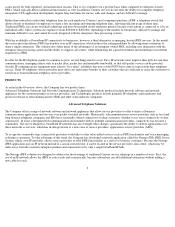8x8 2000 Annual Report Download - page 17
Download and view the complete annual report
Please find page 17 of the 2000 8x8 annual report below. You can navigate through the pages in the report by either clicking on the pages listed below, or by using the keyword search tool below to find specific information within the annual report.customers to add their own features and functionality to the device software provided by the Company. The RISC cores access 32-bit
instructions and data through a bus that interfaces to internal and external static random access memory (SRAM). The RISC core in the
Audacity-T2 semiconductor also contains an extended instruction set to execute specialized DSP instructions.
The Company's DSP core architecture is a SIMD processor that implements computationally intensive video, audio and graphics processing
routines as well as certain digital communications protocols. The DSP core in the VCP and LVP semiconductors operates at frequencies up to
72 MHz, while the VCPex and Audacity ITP DSP cores operate at 80 MHz. A new version of the Audacity ITP DSP core is in design which is
intended to operate at up to 125 MHz. The DSP cores are programmable with a proprietary instruction set consisting of variable-length 32-bit
and 64-bit microcode instructions that provide the flexibility to improve algorithm performance, enhance video and/or audio quality and
maintain compliance with changing digital video, audio, graphics and communication protocol standards. The DSP cores access their
instructions through an internal bus that interfaces to on-chip SRAM and ROM that is preprogrammed with video and audio processing
subroutines.
The RISC and DSP cores combined provide an efficient and flexible architecture that can be reconfigured through a change of application
software. This flexibility allows the architecture to implement the fundamental processing steps that form the basis of MGCP, SIP and H.323
standards-based audio telephony systems and H.320, H.323 and H.324 (together, H.32x) standards-based video communication systems in
embedded software that runs on the integrated circuit device.
CUSTOMERS AND MARKETING
Advanced Telephony Solutions
CUSTOMERS -- During fiscal 2000, the Company announced the Netergy iPBX Server Software and a limited external deployment of hosted
iPBX services based on it by Dialink, a competitive local exchange carrier (CLEC) based in the San Francisco Bay Area. In addition to the
Dialink customer trial, the Company is in laboratory trial testing with several other service providers and has obtained INIP certification, which
provides for system interoperability with leading telecommunications vendor products. The Company is currently establishing contact with a
range of service providers in preparation for general availability of the iPBX software product in the second half of fiscal 2001.
SALES AND MARKETING -- The Company markets the iPBX software and integrated third-party software products through a direct sales
force. In addition, the Company has established a relationship with Exodus Communications, a hosted service provider partner, and intends to
establish relationships with system integrators that can serve as resellers. The sales force operates from the Company's headquarters in Santa
Clara, California, to support sales in North America. The Company uses a combination of employees and outside contractors to provide the
business modeling tools, sales presentations, product literature and technical publications (white papers) necessary to support the direct sales of
the iPBX products. The Company also utilizes several marketing programs to support the sale and distribution of its products, including
participation in industry trade shows and conferences. The Company also publishes technical articles, distributes sales and product literature
and has an active public relations plan to encourage coverage of the Company's products and technology by the media.
COMPETITION -- The Company competes with suppliers of traditional PBXs, Centrex equipment and newer generation IP-based solutions
that seek to sell such products to telecommunication service providers, which in turn offer voice services to the Small Medium Enterprise
(SME) marketplace. This market is rapidly shifting to a network centric, IP-based solutions model. New IP-based solutions are cannibalizing
traditional markets due to increased efficiencies of IP technology, lower costs, increases in return on investment (ROI), improved features sets
and the requirement for rapid innovation. As an IP-based solution, the Solutions iPBX product competes by leveraging the innate efficiencies
of IP architectures and combining those efficiencies with best-of-class features from competitive products. This market is characterized by
rapid technological change, intense competition and first mover advantage.
14
























